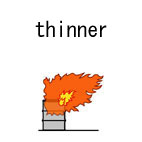| Case Name |
Leakage and fire of adhesives from the drain valve of an adhesive tank |
| Pictograph |

|
| Date |
December 2, 1994 |
| Place |
Kawasaki, Kanagawa, Japan |
| Location |
Steel mill |
| Overview |
There was a small fire at a coating machine for steel pipes at a steel mill. The machine was stopped because scheduled production for the month had been completed. An overhaul was carried out in preparation for the next run. An electrical sander was used inside the coating machine to repair some parts. The sander operator discovered a fire in the oil pan. Adhesives had leaked out into the oil pan from the drain valve of the adhesive tank piping. As the drain valve was of the handle cock type with an easily moved handle, the leak from the drain valve was considered to have been caused by the valve being half-opened by contact with a cover sheet or a worker. |
| Incident |
At a machine for coating steel pipes, leaked combustibles from an adhesive tank caught fire due to hot work during downtime. |
| Processing |
Manufacture |
| Individual Process |
Maintenance |
| Substance |
Thinner |
| Adhesive |
| Type of Accident |
Leakage, fire |
| Sequence |
The coating machine stopped because scheduled production for the month had been completed. On December 1st, 1994, an overhaul of the machine started. On December 2nd, the driving chain was being cut with an electrical cutter to correct the angle of a tube inside the coating machine. At that time, adhesive agents stored near the oil pan was ignited by a spark from the electrical cutter. |
| Cause |
1. The cause of leakage; A drain valve of piping attached to the tank that contained a mixture of combustible thinner and adhesives was half-opened without anyone being aware of it. The liquid mixture leaked from there into the oil pan. As the drain valve was of the handle cock type, it might have been half-opened by contact with a sheet or a worker when he spread the dustproof sheet for protection during hot work.
2. The cause of ignition; Sparks generated during chain breaking work by a sander ignited combustible vapor from the adhesive liquid mixture that leaked into the oil pan.
3. Reasons for improper hot work. a) Insufficient safety countermeasures during temporary hot work. b) Insufficient instructions of safety countermeasures to subcontractor's workers.
Therefore, the subcontractor's workers did hot work without confirming safety first near a place where combustible vapor could be generated.
4. Summary.
As the drain valve was of the handle cock type, the valve was half-opened by contact with a sheet or a worker. Therefore, fluid in the tank leaked from the drain valve into the oil pan. As safety countermeasures were not prepared for cutting work using an electrical sander, sparks from the sander ignited the combustible vapor in the pan. |
| Response |
Workers extinguished the fire with five fire extinguishers. |
| Countermeasures |
1. The drain valve on the leaking piping and the tank drain valve are changed from the handle cock type to the globe valve, and a plug or a cap is installed at the tip.
2. A frame made of iron is installed near the valve to prevent easy contact between workers and objects.
3. Hot work standards in the factory are clarified.
4. Construction safety performance criteria are decided.
5. Education on fire management in hazardous facilities is provided for the workers including those of subcontractors. |
| Knowledge Comment |
1. This accident occurred during downtime. In comparison with normal working hours, workers might become lax. However, they need to be fully aware of safety.
2. It is necessary to take care in handling a cock valve, as it is easily opened. |
| Background |
1. The main cause is considered to be a lack of attention of the management and workers. For example, the way of approving hot work and safety confirmation were inadequate.
2. A cap was not installed at the tip of the drain nozzle. A cap should be prepared to prevent a seat leak, etc. This is one of the basic requirements of site and operation management. |
| Reason for Adding to DB |
Example of fire at a handle cock valve which was opened without being noticed |
| Scenario |
| Primary Scenario
|
Carelessness, Insufficient Precaution, Carelessness of Operator, Organizational Problems, Poor Management, Poor Mangememt of Repir Work, Usage, Maintenance/Repair, No Confirmation of Site Condition at Beginning of Repair, Planning and Design, Poor Planning, Poor Design, Secondary Damage, External Damage, Fire
|
|
| Sources |
Kawasaki City Fire station, Prevention section, Peace division, N iron Co . M steel mill Fire at pipe coating machine. Material of the Kawasaki City complex safety countermeasure committee (1995)
|
| Physical Damage |
About 70 L of a liquid mixture of thinner and adhesives leaked, some of which burned. A dustproof sheet and a motor burned. |
| Financial Cost |
¥33,000 (Material of the Kawasaki City Complex safety countermeasure committee) |
| Notes |
The accident occurred during an overhaul. Such work might be done by a subcontractor who might lack safety awareness. As workers of a subcontractor are not permanent employees, there might be insufficient training and safety education. |
| Field |
Chemicals and Plants
|
| Author |
KOSEKI, Hirosi (National Research Institute of Fire and Disaster)
TAMURA, Masamitsu (Center for Risk Management and Safety Sciences, Yokohama National University)
|